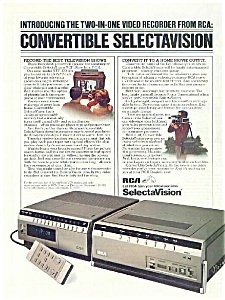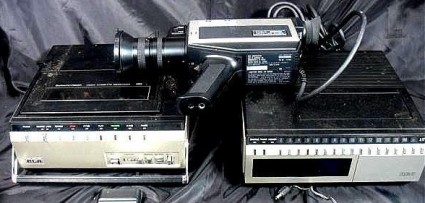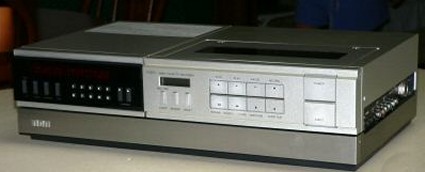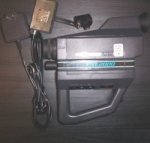This is the third in a series of articles about my recent quest to replace a broken VCR in this era of DVDs, DVRs, and other newfangled gadgets. Click here for the beginning of the series.
When Sony first introduced the Betamax video recorder I immediately began reading up everything I could about them and later about the competing VHS format introduced by JVC. It was very interesting to watch the battle between these two incompatible tape formats. Although VHS was of inferior quality, it became more widely accepted. Eventually VHS pushed Betamax out of the marketplace thanks to restrictive licensing policies by Sony and the porn industry’s acceptance of VHS. Check out this article about the rise and fall of Beta. The current a battle between incompatible competing Sony BluRay DVD and HD DVD formats is reminiscent of the old Betamax versus VHS battle.
I kept hoping that prices would come down so that I could someday afford one of these dream machines of either format. I remember talking to a salesman about a $450 Betamax and he assured me that never in my lifetime would I see a VCR cheaper than $400. “They are just too complicated a machine to be made any cheaper than that” he insisted. I had spent too much time working with computers and their ever falling prices and ever-increasing capabilities to know that that was a ridiculous assumption. As I said earlier, VCRs bottomed out at about $50-$60 before their untimely demise.

Thanks to a rather generous disability insurance policy from when I worked at IU Genetics Research, I managed to find myself with an unusual amount of disposable income and ended up paying about $1300 for my first VCR. It was an RCA SelectaVision convertible VCR model VFP-170. I’m not sure when I purchased it but here’s a press release dated February 1981. The image on the right is an advertisement for this model. It was called convertible because it was designed to be used as both a tabletop and a portable VCR to be used with a separate video camera. My friend Stu Byram (the one who recorded me singing ” I’m a little Teapot” as a toddler) also had been that same model VCR and had a camera to go with it On a couple of occasions he loaned me his camera to use with my portable recorder.
Amazingly this machine was so primitive that the remote-control was hardwired. That’s right… to work the remote-control you had to drape a 10 foot wire from your TV set to your easy chair. Below are some images of another almost identical model VGP 170 NR which did finally come with a wireless remote. This recently listed on eBay with a minimum bid of $19.95 and it include a camera but it had no bids! As I said earlier I paid $1300 for it.
In this image the piece on the right is the tuner which remained connected to your television and your antenna (this was pre-cable days). The piece on the left was the “portable” recorder which connected to the tuner by a thick cable in the back.
Note that the tuner section had a series of about a dozen buttons which were used to select the channel to record. If you opened a little access hatch on top they were a series of a dozen tiny little thumb wheels that you used to manually tune in your stations. There was a little tiny toggle switch to select VHF channels 2-13 or UHF channels 14-82. The concept of a “cable ready” device was still years off. You could program the device to record anything up to 14 days in advance and not only would it record in standard SP two-hour mode it would also record in four-hour LP mode but it also would use the new six-hour SLP recording mode!
A few years later my uncle Keith bought the RCA model VJP900 which is shown here.


Rather than connect the two pieces using a cable, this one had a sort of docking station that you used to connect the portable section. The model shown here sold on eBay recently for $1.75. Ironically Keith never did buy a camera to go with his “convertible” VCR.
Eventually I did buy an RCA camera of my own to go with it. Note in these days they didn’t call them camcorders because they were not camera and recorder all in one. Dad created a camera mount that allowed me to connect the camera to my wheelchair armrest. We would hang the recorder section on the back of my wheelchair in a bag and even supplanted the battery power of the recorder by plugging a cable into my wheelchair battery. We had to wire in three little buttons on the end of a cable so that I can use the pause/record, zoom in, and zoom out functions. I will have more on these famous the buttons in a later installment here.
I really liked my uncle’s VCR because it had stereo sound capability and you could audio dub to put in narration, music or sound effects. I borrowed his VCR one time so that I could do tape to tape editing of some video I shot in the garage area at the Indianapolis Motor Speedway. I put music in one stereo channel and did narration in the other channel.
I recently dug out that old edited videotape that I had shot at the Speedway which included in narration. Much to my surprise the narration was no longer there. That old stereo VCR used linear recording tracks instead of the flying heads that modern hi-fi stereo VCR’s used today. apparently current VCRs can’t handle that kind of stereo any more.
I don’t remember why or when I got rid of that VCR. At some point I replaced the camera with a new 8mm camcorder. I seem to recall my next big VCR was a very fancy model for which I paid about $900. Its claim to fame was something called “digital effects”. It had some sort of digital frame buffer that when you hit the pause button it would digitally capture the frame and display it perfectly clear from the buffer. It also had some other digital effects built in similar to the kinds of special effects you find built into today’s camcorders. I thought I would use these effects in editing videos but it turned out I never really did any more of that kind of thing.
Well that’s enough nostalgia for now… in the next installment we will talk about about my quest to replace my Toshiba VCR with a VCR/DVD combo even though I didn’t need the DVD section in my bedroom. I will discover it’s not as easy as I expected it to be.
